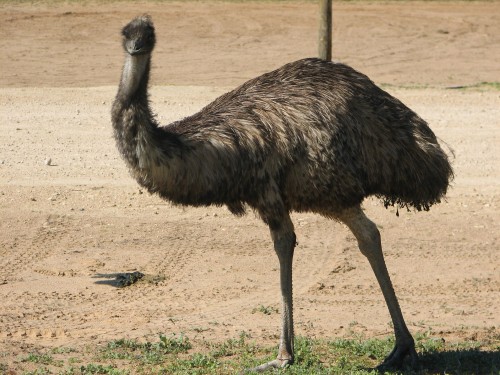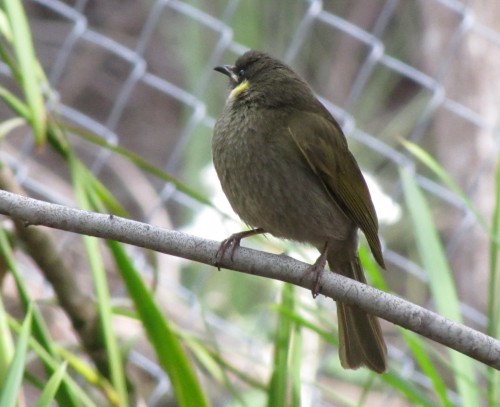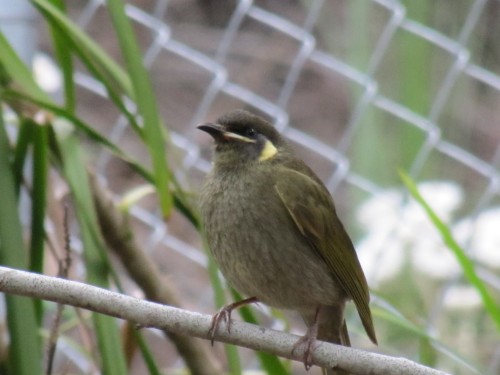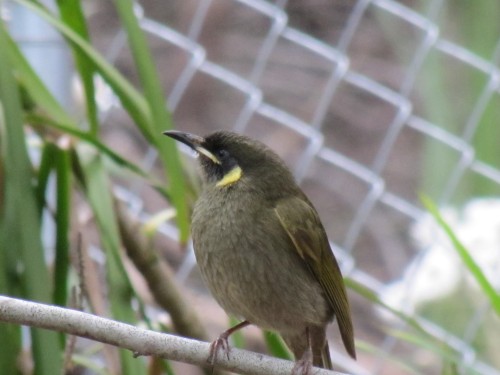Superb Parrot
On our recent trip to Sydney we stopped quite a few times for a meal break, to refuel or to change drivers. Generally we choose meals breaks where we know we have a good chance of seeing at least some birds. We’ve travelled this route many times in the last 15 years so we can visit family who live in Sydney. These trips have become very regular in the last four years. Grandchildren (ages nearly 5 and nearly 2) are something of an added attraction these days.
On our most recent trip a few weeks’ ago we didn’t get any chances to get out birding in the Sydney region itself. The first 10 days were very wet and cold, and them I spent the rest of the time confined to quarters with bronchitis. I’m still not fully over it three weeks later.
I did manage a little birding at meal breaks on our return journey. We were planning on stopping at the Wagga Wagga Botanic Gardens on the first day of our return trip, but fading light and a bitterly cold wind convinced us to press on towards Narrandera for the night. Just east of Wagga Wagga we stopped at a roadside rest area in the Borambola district to change drivers. As I opened the car door my attention was immediately caught by a bird call. It was coming from a eucalyptus tree some twenty metres from where we’d parked the car. I whipped out the binoculars – sadly they’d been neglected for most of our trip – and searched for the bird. Eventually I found it sitting right at the outer foliage of a tall tree, with only its head and neck showing. Too high for a photo and only just enough of the bird showing to give positive identification.
This was only about the third time I’ve seen a Superb Parrot, aptly named for its wonderful colours. Because I didn’t get a photo on this occasion I’ve used one I took in an aviary at the Adelaide Zoo a few years ago.
Further reading:
- Wagga Wagga Botanic Gardens
- Superb Parrot page on Birds in Backyards site
Birding at 100kph on the Hay Plains
My wife and I have just returned from a road trip to Sydney to visit family. Grandchildren can be so persuasive; “We insist you come to stay with us,” said Mr Nearly Five Years Old.
We didn’t get to do much birding because of the wet weather, and the fact that I came down with a severe case of bronchitis while there; as I write this I’m still in the throes of that dreaded lurgy. (“Cough! Cough!”)
While we have flown over to Sydney on several occasions – it’s nearly 1400km each way – we prefer to drive because we enjoy the passing scenery, flora and fauna and the birds, of course. Yes, it’s tiring travelling non-stop for two full days, but we take it in turns to drive. When I’m at the wheel my wife records the birds I see and can identify along the road. Identification can be challenging when hurtling along at 100kph on a busy highway. And when it’s my wife’s turn to drive I can give a little more attention to what is flying around, or sitting on the roadside – or even on the road itself.
I usually try to arrange to be the passenger when we are crossing the Hay Plains between the towns of Balranald and Hay in far western New South Wales. This long stretch of road has huge expanses of grassland and saltbush with only the occasional tree until the last 20km just east of Balranald. Usually the birding along the 130km road is excellent with plenty of birds of prey. On this trip however, I saw few birds other than Emus.
Usually I count on seeing perhaps up to ten or a dozen Emus along this road, but on this occasion I estimate there were between 50 and 80. I didn’t count them but one loose flock alone numbered around 20. as for the rest there were numerous groups of two, three or four. It was certainly the most I can ever remember seeing on this stretch of road, one we’ve travelled on many occasions when travelling to Sydney to visit family. (Now that we have grandchildren there as an added incentive, we are travelling over there up to three times annually.)
Related articles:
- Birding on the Hay Plains – articles from my archives
King Parrots in Artarmon, Sydney
When we go to Sydney to visit family, we stay with our son and his family in Artarmon, several train station stops north of the Harbour Bridge. This area has many trees lining the streets, many more in gardens and there are several parks in the vicinity. While the birding is not great in terms of numbers of species, the bird life is still quite interesting.
The common species include: Noisy Miners, Australian Magpies, Australian Ravens, Common Mynas, Rainbow Lorikeets, Rock Doves, Laughing Kookaburras, Grey Butcherbirds and Pied Currawongs. From time to time I see Welcome Swallows, Galahs and Sulphur-crested Cockatoos. On one visit we even had a Boobook Owl in a tree in the garden.
More recently, my son – who has just a little more than a passing interest in birds – reported seeing a small group of 4 or 5 King Parrots frequenting his garden, or the street trees nearby. He hasn’t had a chance to get a photo yet, and I didn’t either on our recent visit last month. I did get several good views of them flying around nearby, but no clear views within camera range. Instead, I’ve included today a few photos of this species seen elsewhere.
Lewin’s Honeyeater
On our recent visit to Sydney to stay with family, my wife and I took out an afternoon to visit the Ku-ring-gai Wildflower Garden near St Ives. we’d been here on a number of other occasions and usually enjoyed the visit.
The gardens are open daily from 8am to 5pm and are accessed off Mona Vale Road. There is no entry fee and the education centre is available for functions for a fee. Extensive walking trails and picnic areas make this a very attractive place to visit, especially for birders and native plant enthusiasts like my wife.
Over a number of visits I have sometimes been a little disappointed with the bird life, but mostly it is quite good. The thick vegetation allows a wide range of small bush birds to hide in safety, but this sometimes can cause a little frustration identifying them, and especially challenging for photography. It was with delight then, that I captured reasonable shots of a Lewin’s Honeyeater. It posed for my camera for several minutes, perching on an exposed branch in range of my lens.
This species is found along the eastern coastal regions of Australia. This was a particularly pleasing sighting as I’ve only ever seen it on several previous occasions.
Ku-ring-gai Wildflower Garden
Sydney Trip Report June 2011
When we stayed with family in Sydney earlier this year we struck an unusually cold and wet period. We were confined to quarters for much of our stay. This was a blessing in one sense; we could spend extra time with our wonderful 2.5 year old grandson. On the other hand it was disappointing not to be able to get out and about exploring some of the wonderful places in and around the city, especially places like the botanic gardens. Birding was consequently not a high priority considering the weather.
One afternoon it cleared up enough for us to make a hurried visit to the Ku-ring-gai Wildflower Garden. We had been there on several occasions before and I knew that the birding can be very good. My wife always enjoys seeing which wildflowers are blooming. Our interests are very complementary.
On this occasion we were both disappointed. While there were some bushes in flower when we visited, we could see that many were still only in bud; we were probably 4-6 weeks early. As for the birding, it was still overcast with dark heavy clouds, occasional drizzle (yes, we had our umbrellas – and used them) and late in the afternoon in fading light. All these elements conspired against seeing many birds.
I only managed a short list of species seen:
- White-eared Honeyeater
- Red Wattlebird
- Laughing Kookaburra
- Rainbow Lorikeet
- Silvereye
- Australian Magpie
- White-browed Scrubwren
- New Holland Honeyeater
- White-throated Tree-creeper
Not an inspiring list, but better than none at all. I managed some poor shots of the lone magpie (which I won’t show here) and several average shots of a solitary White-eared Honeyeater which I’ll post here in a few days’ time.
Meanwhile I’ll show some of the wildflowers seen.












